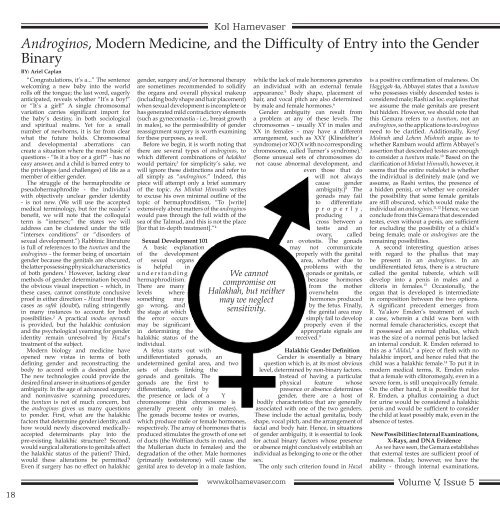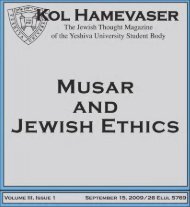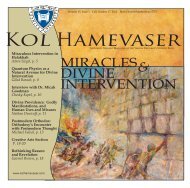The Other in Judaism - Kol Hamevaser
The Other in Judaism - Kol Hamevaser
The Other in Judaism - Kol Hamevaser
Create successful ePaper yourself
Turn your PDF publications into a flip-book with our unique Google optimized e-Paper software.
Androg<strong>in</strong>os, Modern Medic<strong>in</strong>e, and the Difficulty of Entry <strong>in</strong>to the Gender<br />
B<strong>in</strong>ary<br />
BY: Ariel Caplan<br />
“Congratulations, it’s a...” <strong>The</strong> sentence<br />
welcom<strong>in</strong>g a new baby <strong>in</strong>to the world<br />
rolls off the tongue; the last word, eagerly<br />
anticipated, reveals whether “It’s a boy!”<br />
or “It’s a girl!” A s<strong>in</strong>gle chromosomal<br />
variation carries significant import for<br />
the baby’s dest<strong>in</strong>y, <strong>in</strong> both sociological<br />
and spiritual realms. Yet for a small<br />
number of newborns, it is far from clear<br />
what the future holds. Chromosomal<br />
and developmental aberrations can<br />
create a situation where the most basic of<br />
questions - “Is it a boy or a girl” - has no<br />
easy answer, and a child is barred entry to<br />
the privileges (and challenges) of life as a<br />
member of either gender.<br />
<strong>The</strong> struggle of the hermaphrodite or<br />
pseudohermaphrodite - the <strong>in</strong>dividual<br />
with objectively unclear gender identity<br />
- is not new. (We will use the accepted<br />
medical term<strong>in</strong>ology, but for the reader’s<br />
benefit, we will note that the colloquial<br />
term is “<strong>in</strong>tersex;” the states we will<br />
address can be clustered under the title<br />
“<strong>in</strong>tersex conditions” or “disorders of<br />
sexual development.”) Rabb<strong>in</strong>ic literature<br />
is full of references to the tumtum and the<br />
androg<strong>in</strong>os - the former be<strong>in</strong>g of uncerta<strong>in</strong><br />
gender because the genitals are obscured,<br />
the latter possess<strong>in</strong>g physical characteristics<br />
of both genders. 1 However, lack<strong>in</strong>g clear<br />
methods of gender determ<strong>in</strong>ation beyond<br />
the obvious visual <strong>in</strong>spection – which, <strong>in</strong><br />
these cases, cannot constitute conclusive<br />
proof <strong>in</strong> either direction – Hazal treat these<br />
cases as safek (doubt), rul<strong>in</strong>g str<strong>in</strong>gently<br />
<strong>in</strong> many <strong>in</strong>stances to account for both<br />
possibilities. 2 A practical modus operandi<br />
is provided, but the halakhic confusion<br />
and the psychological yearn<strong>in</strong>g for gender<br />
identity rema<strong>in</strong> unresolved by Hazal’s<br />
treatment of the subject.<br />
Modern biology and medic<strong>in</strong>e have<br />
opened new vistas <strong>in</strong> terms of both<br />
def<strong>in</strong><strong>in</strong>g gender and reconstruct<strong>in</strong>g the<br />
body to accord with a desired gender.<br />
<strong>The</strong> new technologies could provide the<br />
desired f<strong>in</strong>al answer <strong>in</strong> situations of gender<br />
ambiguity. In the age of advanced surgery<br />
and non<strong>in</strong>vasive scann<strong>in</strong>g procedures,<br />
the tumtum is not of much concern, but<br />
the androg<strong>in</strong>os gives us many questions<br />
to ponder. First, what are the halakhic<br />
factors that determ<strong>in</strong>e gender identity, and<br />
how would newly discovered medicallyaccepted<br />
determ<strong>in</strong>ants play <strong>in</strong>to the<br />
pre-exist<strong>in</strong>g halakhic structure Second,<br />
would surgical alterations to genitals affect<br />
the halakhic status of the patient Third,<br />
would these alterations be permitted<br />
Even if surgery has no effect on halakhic<br />
gender, surgery and/or hormonal therapy<br />
are sometimes recommended to solidify<br />
the organs and overall physical makeup<br />
(<strong>in</strong>clud<strong>in</strong>g body shape and hair placement)<br />
when sexual development is <strong>in</strong>complete or<br />
has generated mild contradictory elements<br />
(such as gynecomastia - i.e., breast growth<br />
<strong>in</strong> males), so the permissibility of gender<br />
reassignment surgery is worth exam<strong>in</strong><strong>in</strong>g<br />
for these purposes, as well.<br />
Before we beg<strong>in</strong>, it is worth not<strong>in</strong>g that<br />
there are several types of androg<strong>in</strong>os, to<br />
which different comb<strong>in</strong>ations of halakhot<br />
would perta<strong>in</strong>; 3 for simplicity’s sake, we<br />
will ignore these dist<strong>in</strong>ctions and refer to<br />
all simply as “androg<strong>in</strong>os.” Indeed, this<br />
piece will attempt only a brief summary<br />
of the topic. As M<strong>in</strong>hat H<strong>in</strong>nukh writes<br />
to excuse his own m<strong>in</strong>imal outl<strong>in</strong>e of the<br />
topic of hermaphroditism, “To [write]<br />
extensively about matters of the androg<strong>in</strong>os<br />
would pass through the full width of the<br />
sea of the Talmud, and this is not the place<br />
[for that <strong>in</strong>-depth treatment].” 4<br />
Sexual Development 101<br />
A basic explanation<br />
of the development<br />
of sexual organs<br />
is helpful <strong>in</strong><br />
understand<strong>in</strong>g<br />
hermaphroditism.<br />
<strong>The</strong>re are many<br />
levels where<br />
someth<strong>in</strong>g may<br />
go wrong, and<br />
the stage at which<br />
the error occurs<br />
may be significant<br />
<strong>in</strong> determ<strong>in</strong><strong>in</strong>g the<br />
halakhic status of the<br />
<strong>in</strong>dividual.<br />
A fetus starts out with<br />
undifferentiated gonads, an<br />
undeterm<strong>in</strong>ed genital area, and two<br />
sets of ducts l<strong>in</strong>k<strong>in</strong>g the<br />
gonads and genitals. <strong>The</strong><br />
gonads are the first to<br />
differentiate, ordered by<br />
the presence or lack of a Y<br />
chromosome (this chromosome is<br />
generally present only <strong>in</strong> males).<br />
<strong>The</strong> gonads become testes or ovaries,<br />
which produce male or female hormones,<br />
respectively. <strong>The</strong> array of hormones that is<br />
produced stimulates the growth of one set<br />
of ducts (the Wolffian ducts <strong>in</strong> males, and<br />
the Mullerian ducts <strong>in</strong> females) and the<br />
degradation of the other. Male hormones<br />
(primarily testosterone) will cause the<br />
genital area to develop <strong>in</strong> a male fashion,<br />
<strong>Kol</strong> <strong>Hamevaser</strong><br />
We cannot<br />
compromise on<br />
Halakhah, but neither<br />
may we neglect<br />
sensitivity.<br />
while the lack of male hormones generates<br />
an <strong>in</strong>dividual with an external female<br />
appearance. 5 Body shape, placement of<br />
hair, and vocal pitch are also determ<strong>in</strong>ed<br />
by male and female hormones. 6<br />
Gender ambiguity can result from<br />
a problem at any of these levels. <strong>The</strong><br />
chromosomes – usually XY <strong>in</strong> males and<br />
XX <strong>in</strong> females – may have a different<br />
arrangement, such as XXY (Kl<strong>in</strong>efelter’s<br />
syndrome) or XO (X with no correspond<strong>in</strong>g<br />
chromosome, called Turner’s syndrome). 7<br />
(Some unusual sets of chromosomes do<br />
not cause abnormal development, and<br />
even those that do<br />
will not always<br />
cause gender<br />
ambiguity.) 8 <strong>The</strong><br />
gonads may fail<br />
to differentiate<br />
p r o p e r l y ,<br />
produc<strong>in</strong>g a<br />
cross between a<br />
testis and an<br />
ovary, called<br />
an ovotestis. <strong>The</strong> gonads<br />
may not communicate<br />
properly with the genital<br />
area, whether due to<br />
problems with the<br />
gonads or genitals, or<br />
because hormones<br />
from the mother<br />
overwhelm the<br />
hormones produced<br />
by the fetus. F<strong>in</strong>ally,<br />
the genital area may<br />
simply fail to develop<br />
properly even if the<br />
appropriate signals are<br />
received. 9<br />
Halakhic Gender Def<strong>in</strong>ition<br />
Gender is essentially a b<strong>in</strong>ary<br />
question which is, at its most obvious<br />
level, determ<strong>in</strong>ed by non-b<strong>in</strong>ary factors.<br />
Instead of hav<strong>in</strong>g a particular<br />
physical feature whose<br />
presence or absence determ<strong>in</strong>es<br />
gender, there are a host of<br />
bodily characteristics that are generally<br />
associated with one of the two genders.<br />
<strong>The</strong>se <strong>in</strong>clude the actual genitalia, body<br />
shape, vocal pitch, and the arrangement of<br />
facial and body hair. Hence, <strong>in</strong> situations<br />
of gender ambiguity, it is essential to look<br />
for actual b<strong>in</strong>ary factors whose presence<br />
or absence might conclusively establish an<br />
<strong>in</strong>dividual as belong<strong>in</strong>g to one or the other<br />
sex.<br />
<strong>The</strong> only such criterion found <strong>in</strong> Hazal<br />
is a positive confirmation of maleness. On<br />
Haggigah 4a, Abbayei states that a tumtum<br />
who possesses visibly descended testes is<br />
considered male; Rashi ad loc. expla<strong>in</strong>s that<br />
we assume the male genitals are present<br />
but hidden. However, we should note that<br />
this Gemara refers to a tumtum, not an<br />
androg<strong>in</strong>os, so the applications to androg<strong>in</strong>os<br />
need to be clarified. Additionally, Kesef<br />
Mishneh and Lehem Mishneh argue as to<br />
whether Rambam would affirm Abbayei’s<br />
assertion that descended testes are enough<br />
to consider a tumtum male. 10 Based on the<br />
clarification of M<strong>in</strong>hat H<strong>in</strong>nukh, however, it<br />
seems that the entire mahaloket is whether<br />
the <strong>in</strong>dividual is def<strong>in</strong>itely male (and we<br />
assume, as Rashi writes, the presence of<br />
a hidden penis), or whether we consider<br />
the possibility that some female genitals<br />
are still obscured, which would make the<br />
<strong>in</strong>dividual an androg<strong>in</strong>os. 11,12 Hence, we can<br />
conclude from this Gemara that descended<br />
testes, even without a penis, are sufficient<br />
for exclud<strong>in</strong>g the possibility of a child’s<br />
be<strong>in</strong>g female; male or androg<strong>in</strong>os are the<br />
rema<strong>in</strong><strong>in</strong>g possibilities.<br />
A second <strong>in</strong>terest<strong>in</strong>g question arises<br />
with regard to the phallus that may<br />
be present <strong>in</strong> an androg<strong>in</strong>os. In an<br />
undifferentiated fetus, there is a structure<br />
called the genital tubercle, which will<br />
develop <strong>in</strong>to a penis <strong>in</strong> males and a<br />
clitoris <strong>in</strong> females. 13 Occasionally, the<br />
organ that is developed is <strong>in</strong>termediate<br />
<strong>in</strong> composition between the two options.<br />
A significant precedent emerges from<br />
R. Ya’akov Emden’s treatment of such<br />
a case, where<strong>in</strong> a child was born with<br />
normal female characteristics, except that<br />
it possessed an external phallus, which<br />
was the size of a normal penis but lacked<br />
an <strong>in</strong>ternal conduit. R. Emden referred to<br />
this as a “dildul,” a piece of flesh with no<br />
halakhic import, and hence ruled that the<br />
child was a halakhic female. 14 To put it <strong>in</strong><br />
modern medical terms, R. Emden rules<br />
that a female with clitoromegaly, even <strong>in</strong> a<br />
severe form, is still unequivocally female.<br />
On the other hand, it is possible that for<br />
R. Emden, a phallus conta<strong>in</strong><strong>in</strong>g a duct<br />
for ur<strong>in</strong>e would be considered a halakhic<br />
penis and would be sufficient to consider<br />
the child at least possibly male, even <strong>in</strong> the<br />
absence of testes.<br />
New Possibilities: Internal Exam<strong>in</strong>ations,<br />
X-Rays, and DNA Evidence<br />
As we have seen, the Gemara establishes<br />
that external testes are sufficient proof of<br />
maleness. Today, however, we have the<br />
ability - through <strong>in</strong>ternal exam<strong>in</strong>ations,<br />
18<br />
www.kolhamevaser.com<br />
Volume V, Issue 5
















